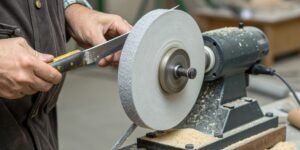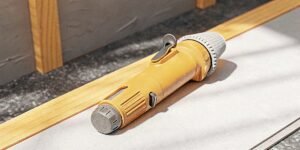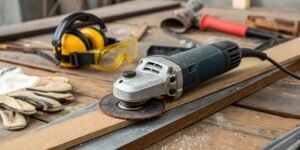
Your glass has rough, sharp edges that are a real safety hazard. Trying to handle or finish the piece can lead to cuts or ruined projects. A glass grinder is the solution.
A glass grinder refines the edges of cut glass, making them smooth and safe for handling. The basic process involves preparing the tool with water, wearing safety glasses, and gently guiding the glass against a spinning, diamond-coated bit to wear away excess material until the desired shape is achieved.

Understanding the steps to use a glass grinder1 is simple. But doing it right takes a bit more knowledge. You need to know how to set it up correctly, what safety rules to follow, and the techniques for getting that perfect, smooth finish. We’ve been making grinding tools for nearly 30 years, and we’ve learned a lot about what works and what doesn’t. Let’s walk through the process together, so you can get great results from the start. Keep reading to learn the details that make all the difference.
What are the basic steps for using a stained glass grinder for the first time?
You’re excited to start your first stained glass project. But that grinder on your bench looks intimidating. One wrong move could break your carefully cut glass piece.
First, fill the grinder’s reservoir with water and make sure the sponge is wet. Put on your safety glasses. Turn the grinder on and firmly guide the glass edge against the bit. Use light pressure and keep the glass moving.

Using a glass grinder for the first time is mostly about preparation and patience. At our factory, we always tell new team members to focus on the setup before the tool even turns on. It prevents so many headaches later. Here’s a simple breakdown I use for training.
Preparation is Key
Before you even think about grinding, get your station ready. First, check your tool. Is the grinding bit2 (the diamond-coated part) securely fastened? Is the power cord in good condition? Place the grinder on a stable, flat surface. Next, add water to the reservoir below the work surface. This water acts as a coolant and is critical. It prevents the glass from getting too hot and cracking. It also turns glass dust3 into a safe sludge.
The Grinding Process
With your safety glasses4 on, you’re ready. Turn on the switch. Hold your glass piece firmly with both hands. Gently bring the edge of the glass to the spinning bit. Don’t push hard. Let the grinder do the work. The goal is to "sand" the edge, not force it off. Move the glass piece constantly along the bit for a uniform, smooth edge. If you hold it in one spot, you’ll create a divot.
| Step | Action | Purpose |
|---|---|---|
| 1. Setup | Fill reservoir, wet sponge, check bit. | Cools glass, traps dust, ensures safety. |
| 2. Safety | Put on safety glasses. | Protects eyes from tiny glass chips. |
| 3. Grind | Turn on grinder, use light pressure, keep glass moving. | Achieves a smooth edge without chipping. |
| 4. Clean | Rinse glass piece, wipe down grinder. | Removes glass slurry, maintains the tool. |
What essential safety precautions should be taken when grinding glass?
Grinding glass is not without risk. You are dealing with electricity, water, and tiny, sharp particles being thrown at high speed. A moment of carelessness can lead to a serious injury.
Always wear safety glasses or a face shield. This is not optional. Make sure your grinder is plugged into a GFCI outlet to prevent shocks. Keep your fingers a safe distance from the spinning bit at all times.

In our manufacturing facility, safety is the first and last thing we talk about every day. A tool is only as good as the person using it safely. Grinding glass combines a few hazards, so following a strict safety protocol is essential. Forget one of these, and you could be in for a bad day.
Protect Yourself (PPE)
Your eyes are the most vulnerable. Tiny chips of glass can fly off the bit unexpectedly. Always wear wrap-around safety glasses or a full face shield. Some people like wearing gloves, but others find they reduce their control over the glass piece. If you do use gloves, make sure they are not loose-fitting. A dust mask is also a good idea if you are doing a lot of dry grinding, though wet grinding is always recommended to control dust.
Electrical and Mechanical Safety
Water and electricity are a dangerous mix. Your grinder must be plugged into a Ground Fault Circuit Interrupter (GFCI) outlet. This will automatically shut off the power if it detects a problem, preventing electrocution. Before starting, quickly inspect the power cord for any damage. Also, make sure the grinder itself is stable and won’t vibrate off your workbench. Never try to grind a piece of glass that is too small to hold safely.
| Safety Area | Precaution | Why It’s Important |
|---|---|---|
| Eye Protection | Wear approved safety glasses or a face shield. | Prevents permanent eye injury from glass chips. |
| Electrical | Use a GFCI outlet and inspect the cord. | Prevents electric shock, especially with water present. |
| Hand Safety | Keep fingers clear of the bit. | Avoids cuts and abrasions from the diamond bit. |
| Work Area | Ensure the grinder is on a stable surface. | Prevents the tool from moving or falling during use. |
How do you create smooth, finished edges on glass with a grinder?
Your ground glass edges still feel rough and have tiny chips. This makes it hard to apply copper foil evenly and gives your final project a messy, unfinished look.
For a smooth finish, use light, consistent pressure and keep the glass moving. After shaping with a standard bit, switch to a fine-grit bit to polish the edge. This second step removes the remaining tiny scratches.

The difference between an amateur and a professional-looking piece often comes down to the edges. A smooth edge isn’t just for looks; it ensures your copper foil adheres perfectly, which leads to stronger solder lines5. Achieving this smoothness is all about technique and using the right tools for the job.
Master Your Technique
Force is your enemy when grinding. Pushing too hard against the bit causes the glass to chip. Instead, just guide the glass with light and steady pressure. Think of it as painting the edge of the glass against the bit. Move continuously. If you stop in one spot, you’ll create a low point. For inside curves, use the entire surface of the bit to your advantage, gently rotating the piece into the curve. For outside curves, sweep the glass across the bit in a smooth, fluid motion.
Use the Right Tool for the Finish
Most grinders come with a standard or medium-grit bit (around 80-120 grit). This is perfect for shaping the glass and removing material quickly. However, it will leave a slightly frosty, textured surface. To get a truly smooth, almost polished edge, you need a second step. Switch to a fine-grit bit6 (200-400 grit or higher). Go back over the edge with this bit, using the same light, steady pressure. This will grind away the tiny imperfections left by the standard bit.
| Grinder Bit Type | Primary Use | Resulting Edge Texture |
|---|---|---|
| Standard Grit | Shaping the piece, removing larger amounts. | Clean but slightly rough, "frosty" appearance. |
| Fine Grit | Polishing the edge after shaping. | Very smooth, clear, and ready for foiling. |
What are the common mistakes to avoid when learning to grind glass?
You’re trying to learn, but you keep chipping glass, stalling the motor, or getting uneven edges. These mistakes are frustrating and can make you want to give up on your project.
The most common mistakes are pushing the glass too hard, letting the bit run dry without water, and trying to grind off too much material at once. Also, avoid grinding with a bit that’s clogged with glass residue.

When I was first learning, I made every mistake in the book. I pushed too hard, convinced that more force meant faster work. The result was a pile of chipped glass and a stalled-out motor. Learning what not to do is just as important as learning what to do. Avoiding these common errors will save you time, money, and a lot of frustration.
The Top Errors to Sidestep
First, excessive pressure. A grinder removes glass by abrasion, not force. Pushing hard will gouge the glass, cause chips along the edge, and can even stall or burn out your grinder’s motor. Let the diamond bit do the work. The second big mistake is grinding dry. The water in your grinder is a coolant and lubricant. Without it, friction creates intense heat that will cause thermal shock7, cracking your glass. It also prevents glass dust from becoming airborne.
Another common error is being too ambitious. A grinder is for refining a shape, not making major cuts. If you need to remove more than 1/8th of an inch (about 3mm), use a saw or score and break the glass again. Trying to grind away large sections takes forever and puts unnecessary wear on your grinder. Finally, pay attention to tool maintenance. A grinding bit clogged with glass dust won’t work efficiently. Periodically clean your bit with a dressing stone to expose fresh diamond grit.
| Mistake | Corrective Action | Why it Helps |
|---|---|---|
| Applying Too Much Pressure | Use light, gentle pressure; let the tool work. | Prevents chipping, stalls, and uneven edges. |
| Grinding on a Dry Bit | Always ensure a steady supply of water. | Prevents heat cracks (thermal shock) and controls dust. |
| Removing Too Much Glass | Use the grinder for refining, not major cuts. | Saves time and reduces wear on the motor and bit. |
| Using a Clogged Bit | Clean the bit regularly with a dressing stone. | Restores grinding efficiency and prolongs bit life. |
Conclusion
Mastering a glass grinder is about patience, safety, and using the right technique. Follow these steps, avoid common mistakes, and you will create smooth, perfectly finished glass for any project.
-
Explore this resource to understand the functionality and benefits of using a glass grinder for your projects. ↩
-
Get insights on selecting the appropriate grinding bit for your glass projects. ↩
-
Find effective methods to manage glass dust and maintain a clean workspace. ↩
-
Learn why safety glasses are essential for protecting your eyes from glass chips during grinding. ↩
-
Discover the relationship between smooth edges and strong solder lines in glass work. ↩
-
Find out how fine-grit bits can help you achieve a polished finish on your glass edges. ↩
-
Understand thermal shock and how to avoid it for better glass grinding outcomes. ↩
Written by
leeon
You may also be interested in:

How to use a hard felt bench grinding wheel on knives?
Getting a razor-sharp, polished edge on a knife can be frustrating and slow. A dull knife is dangerous, and using the wrong tool can easily

What is the smallest angle grinder?
Finding a grinder for tight spaces is tough. The wrong tool damages your work. Let us guide you to the perfect compact angle grinder for

When should you use an angle grinder?
Feeling unsure about which tool to grab? Using the wrong one can waste materials and time. An angle grinder is a powerful, versatile solution for

Can I use a bigger disc on an angle grinder?
You have a job to do, but the only disc you have is larger than your grinder. Using it seems like a quick shortcut. But

Why Do We Need Grinding?
Your parts don’t meet precision requirements, leading to poor performance and costly rejects. Grinding is the essential final step that delivers the perfection your high-quality

How to find grinding equipment manufacturers and suppliers?
Finding the right equipment supplier is a huge challenge. A bad choice can lead to production delays and wasted money. With a clear strategy, you
